Below we profile three final projects created in Professor Stephen Turk’s second year undergraduate installation class conducted during spring 2009 at the Knowlton School of Architecture at the Ohio State University. This studio deals with material fabrication, notation and fundamental representational skills. The images are from the students’ preliminary results from their research analysis and design investigations and the final installation in the Knowlton School of Architecture.
1. THE SCREEN MACHINE:
Project team: Ross Hamilton, Heather Brandenburg, Sarah Simeon, Minyoung Kim.
The Screen Machine is an installation that reveals and conceals the body. The Screens are made to reconfigure an open space, thereby inviting new pathways for people to move. Beyond reconfiguring the space, the screens perceptually reconfigure the body, as onlookers peering into the screens or gazing from a distance perceive a fragmented body as they catch sight of pieces and parts of the human form through open slits in the screens. The placement, size and design of the slits were determined by examining the cues in One Flat Thing, reproduced.
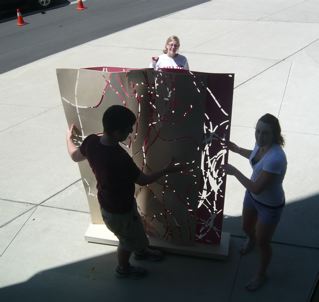
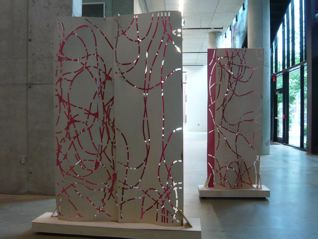
Ross Hamilton describes his intentions and methods in creating The Screen Machine:
“In researching the dance, I chose to focus on the interactions between the dancers that occur in the form of cues. These cues occur throughout the dance in various frequencies. As I moved away from looking directly at the connections between dancers, I began to focus on the number of dancers interacting within a certain time frame. I placed the time frames of the dance into various levels of density. I then used multiple patterns to describe these differing levels. These patterns were then used to create screens of varying porosity by translating the density of interaction within the dance to change the amount of the human figure visible through the screen. This reflects the “blurring” of the individual human figure which we perceived as occurring in the dance.”
2. CUBES:
Project team: Robert Scott, Jason Lee. Caleb Chamberlain, Emily Wright, Sameer Sharif
Cubes is an installation of performative objects, created for users to assemble and reassemble, discovering new alignments between slots cut into the sides of each module. As a system of combinatorial elements, Cubes also explores counterpuntal relationships in the space between the body of the user and the placement of a cube. Cubes was inspired by Forsythe’s use of counterpoint in One Flat Thing, reproduced, as the project team looked for moments of counterpoint in the placement, spacing, and orientation of the cubes.
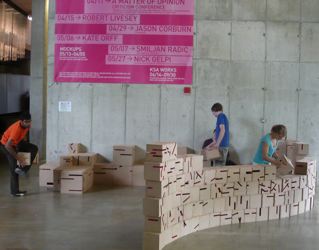
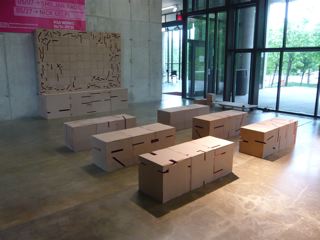
Robert Scott describes his intentions and methods in creating Cubes:
“The analysis of the dance began with a study of movement and shoulder alignments. This data was then combined to form a new diagram in which the alignment lines transected the movement pixels. These pixels became voxels, and became the primitive units for the installation. I then studied the alignments and contrapuntal relationships of the dancers. These relationships form the system by which the primitives are organized. The voxels are free to be moved by visitors who essentially re-choreograph the dance with each movement. The stacks of voxels move from foreground to background, and as they move, visitors will notice alignments and contrapuntal relationships between cubes that are spread throughout the installation.”
3. PAPER CLIPS:
Project Team: Jeff Anderson, Lauren Miller, Sally Cejauskas, Avery Brooks
Papers Clips is an installation that examines the absence and presence of motion, measuring the density of an action inscribed in a space overtime. Examining the entrances and exists in a 5-second section of One Flat Thing, reproduced, Jeff Anderson and his team created a map that charted the absence of a movement as a dancer exited the performing area. The strands of hanging paper clips hung above the visitors to the installation, vary in length depending on the density of movement at that particular second in the dance.
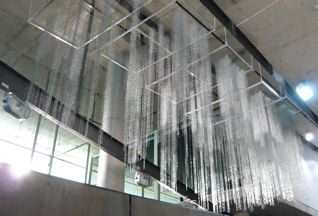
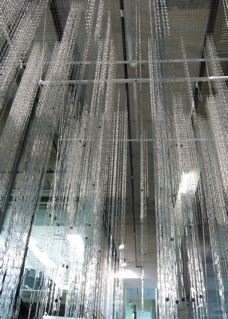
Jeff Anderson describes his intentions and methods in creating Paper Clips:
“I began my project by analyzing the different objects on the Synchronous Objects website. The design plots the change in dancer position over time at five-second intervals for the entire dance. This created an object reminiscent of a DNA strand, and I began to analyze it and pick pieces out of it. Eventually I created a diagram of the absence over time of each dancer from the performance. This formed the gradient upon which I based the rest of my project. I wanted to apply the gradient sensation to a hanging material, and I settled on chains of paper clips. I took apart the gradient I had made into different pieces and mapped the density in the gradient through space.”
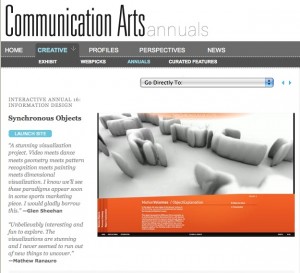


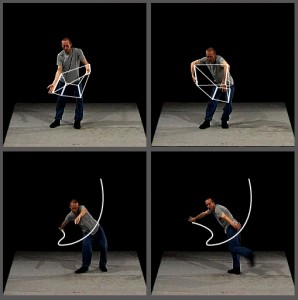
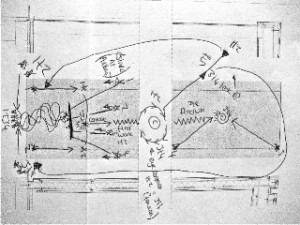
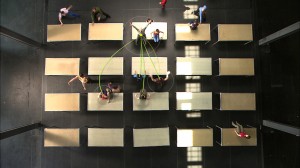
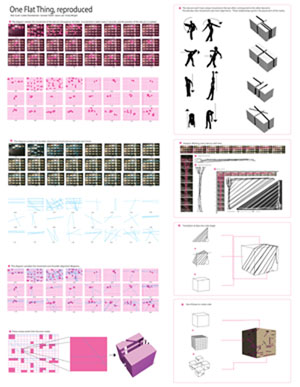







Recent Comments